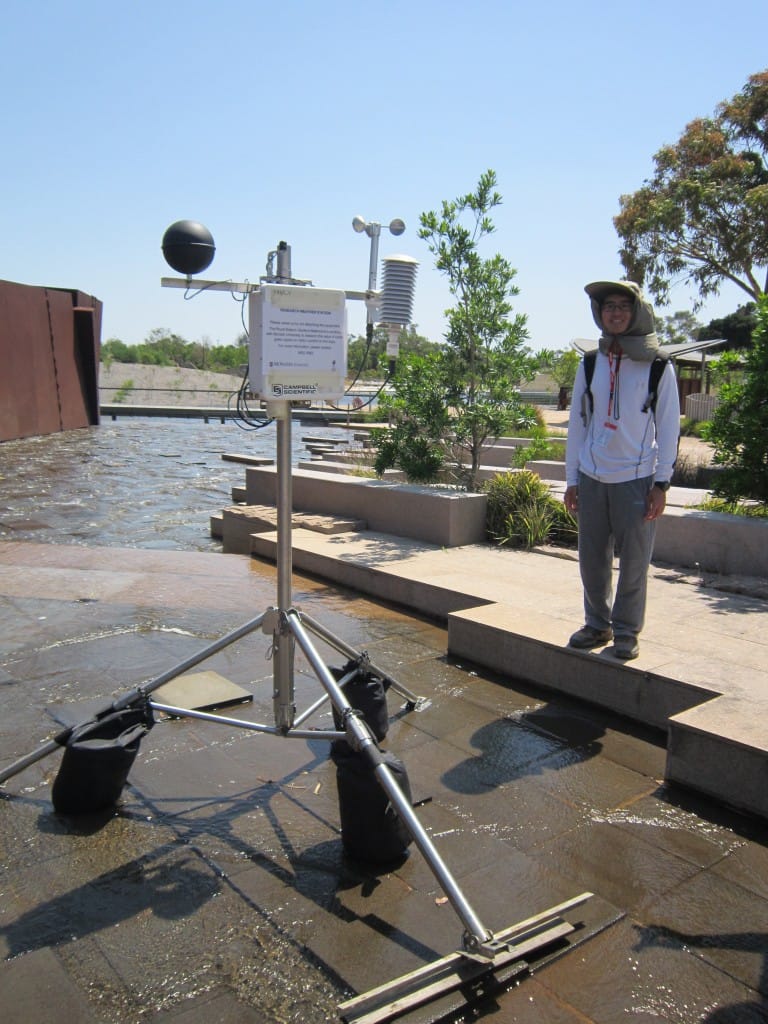Surviving the heat using green urban microclimates
Hottest month on record. This headline has become all too common in recent times as the harsh reality of a warming climate is starting to hit home. As the regular heatwaves in the Australian summer are getting hotter the need for thermal comfort for residents and tourists alike is becoming an important issue. The most environmentally and economically friendly solution could be as simple as improving and promoting the many green urban spaces common in most Australian cities.
There are a range of physical and psychological factors that can influence an individual’s thermal comfort, and understanding these factors is critical for the development of green urban spaces suitable to a wide range of visitors. Studying The design of the public realm to enhance urban microclimates (Project B3.2), CRC for Water Sensitive Cities (CRCWSC) researchers uncovered some interesting and even surprising data that will help improve the design of thermally sustainable green spaces.

Data obtained in two geographically and environmentally distinct sites of the Royal Botanic Gardens Victoria (RBGV) – Melbourne Gardens, and Cranbourne Gardens – clearly showed lower temperatures within the highly shaded areas of the gardens by 2–4 °C and 1–2 °C respectively. Somewhat surprisingly these cooler temperatures within the gardens did not attract more visitors during a recent heatwave, where the temperatures in Melbourne reached over 40 °C. In fact, a significant decrease in visitation to Cranbourne Gardens was seen during this heatwave. Cho Kwong Charlie Lam, a CRCWSC PhD student at Monash University, said “because of the desert-like design of these gardens people perceive it as too hot; but people’s perception is not the same as the actual temperature recorded.”
Interestingly, Charlie also noticed that “the relative comfort at a given temperature following a heatwave was higher then that for the same temperature before the heatwave, suggesting a psychological component to thermal comfort.”
This psychological factor combined with the type and amount of clothing worn by visitors to the park had a profound effect on thermal comfort. The CRCWSC team discovered that there was a clear cultural difference in thermal comfort, with tourist from Europe being more tolerant to the heat than both Australian residents and Chinese tourist. Both the expectations of hot temperatures and the clothing worn by European tourist are thought to explain their heat tolerance levels. This again suggests that the perception of temperature plays a central role in thermal comfort. This difference in thermal comfort levels between people from different cultural backgrounds raises a critical issue for the design of public spaces that are required to cater for a wide range of people.
Translating research into design
To better understand the thermal properties of the Royal Botanic Gardens (RBG) in Melbourne, the CRCWSC team undertook detailed thermal mapping on a microscale level as part of RBG Melbourne’s Landscape Succession Strategy. Combined with other inputs – such as access to drinking water and shading – this data is now being considered in a scoring matrix to elicit the overall human comfort levels in various areas of the gardens. This information is vital to the development of the Melbourne Gardens Master Plan, which is to be renewed in June and will prioritise the development projects over the next 10 years.

The thermal mapping data has revealed that even the most popular areas within the Melbourne Gardens could be improved, with the Observatory Gate precinct – where the Visitor Centre is located – scoring low on this thermal comfort matrix.
Andrew Laidlaw, Landscape Architect for the RBG, said that “we now realise a lot of our pathways are highly exposed to heat. This information will help to work out priorities for the Master Plan: bringing more shade into those areas; bringing more accessible drinking water to those areas.”
While the data obtained by CRCWSC researchers is vital for the Master Plan of the Melbourne Gardens, it has also helped in the development of other projects aimed at cooling and promoting visitation to the gardens during these summer heatwaves. A recent initiative could bring cooling sculptures to the park which would utilise water-misting units that Andrew says “do not get you wet, but drop the temperature by 4–5 °C, helping to showcase the advantages of the gardens on hot days.”
The next step to ensure the best outcome for RBG Victoria in capitalising on this research will rely on community engagement, with a public consultation scheduled for the Master Plan which will discuss key aspects of the Melbourne Gardens' future: including the effect of climate change and the thermal comfort of its visitors.
Nick Proellocks for the Mind Your Way team
Further reading
Cooling Effect of Irrigation and Tree Shading in Urban Green Space – Charlie Lam’s PhD poster
Impacts of water sensitive design solutions on human thermal comfort
Lam, Loughnan, and Tapper (2015) “Visitor perception of thermal comfort in two contrasting public landscape gardens during extreme heat events”. 9th International Conference on Urban Climate/12th Symposium on the Urban Environment